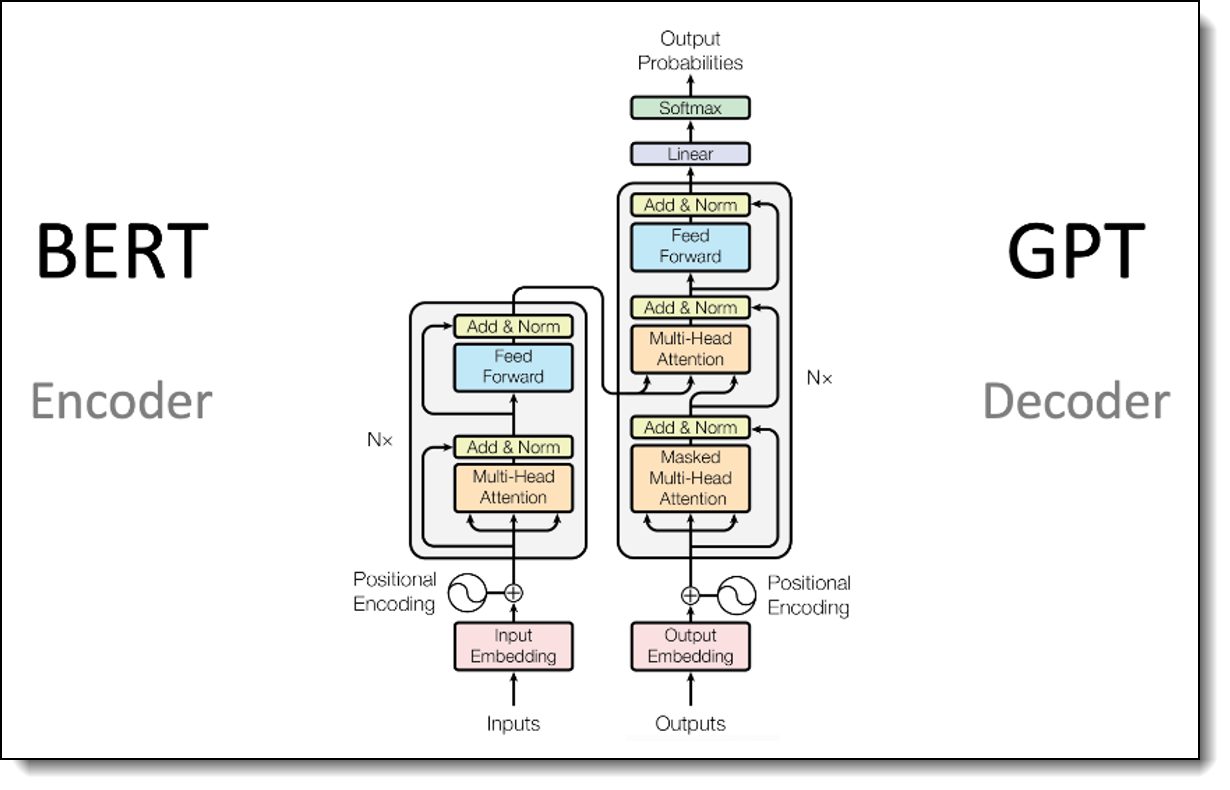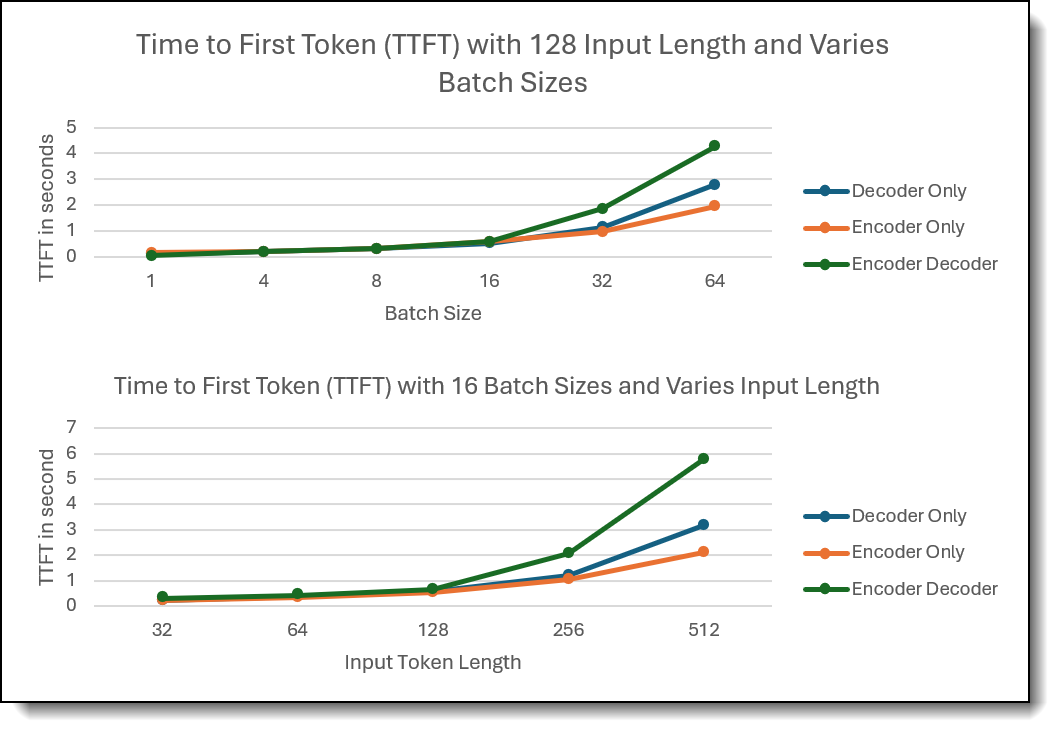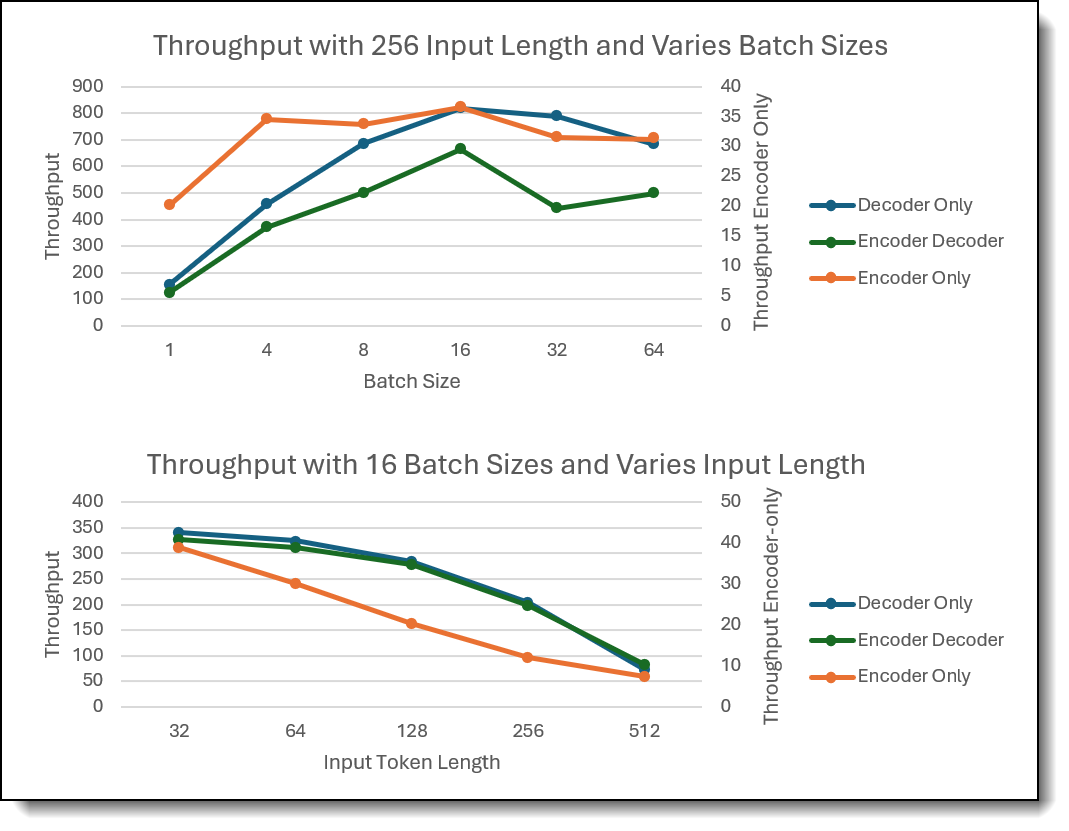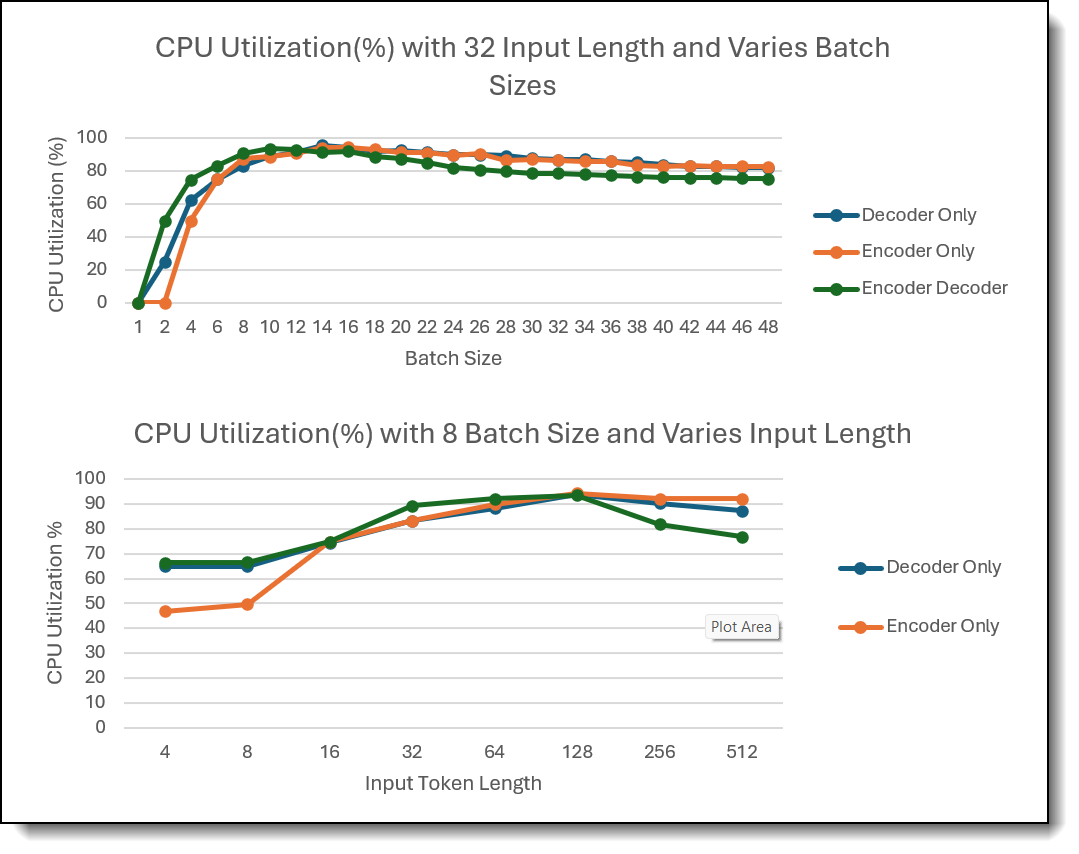Authors
Published
14 Feb 2025Form Number
LP2148PDF size
11 pages, 501 KBAbstract
Large Language Models (LLMs) play a crucial role in modern AI applications, but their performance is heavily influenced by the underlying hardware infrastructure. In this paper, we focus on evaluating the efficiency and suitability of three popular LLM architectures—encoder-only, decoder-only, and encoder-decoder. We test the performances of three LLM architectures using models of comparable sizes and analyze the results. This series of papers is specifically tailored to Intel’s hardware and software ecosystem. This paper, Part 1, introduces the idea that LLM architectures have an impact on the AI performance. In Part 2 and Part 3, we will demonstrate more Intel technologies such as Intel AMX, Intel Extensions for PyTorch, and Intel AVX-512.
This paper is aimed at AI Data Scientists, AI Engineers, AI Consultants, and AI Enthusiasts who seek to optimize LLM performance on CPU-based infrastructures. It is assumed that readers have a fundamental understanding of LLM architectures and AI inference workloads. The goal is to provide insights into their performance across diverse use cases, helping practitioners understand the most appropriate model for their needs and performance expectation.
Introduction
This paper is the first in a three-part series analyzing the performance of large language models (LLMs) on Intel CPUs. Through detailed benchmarking, we assess latency, throughput, and resource utilization, providing insights into the performance of different model architectures and their computational efficiency.
The main idea is to provide comparative insights into how different LLM architectures leverage Intel CPU resources rather than focusing on absolute performance values. If specific benchmark numbers do not meet business expectations, they should be interpreted as relative comparisons rather than definitive performance constraints.
This series of papers is specifically tailored to Intel’s hardware and software ecosystem. This document, Part 1, showcases how LLM architectures impact the AI performance based on key inferencing benchmarks. In Part 2 and Part 3, we will introduce Intel-exclusive technologies such as:
- Intel Advanced Matrix Extensions (Intel AMX) for enhanced AI acceleration
- Intel Extension for PyTorch (IPEX) for optimized deep learning inference
- Intel Advanced Vector Extensions 512 (Intel AVX-512) for workloads and usages acceleration
These Intel-specific optimizations play a crucial role in improving inference performance and energy efficiency.
Intel CPUs and their use with AI workloads
The Lenovo Press paper Accelerating RAG Pipelines for Enterprise LLM Applications using OpenVINO on the Lenovo ThinkSystem SR650 V3 with 5th Gen Intel Xeon Scalable Processors highlights the SR650 V3 exceptional scalability and performance for Generative AI workloads. Designed to meet low-latency requirements (~100ms) for applications like real-time chatbots, this 2U server offers advanced features such as support for DDR5-5600 MT/s memory, Intel Advanced Matrix Extensions (AMX), and flexible storage configurations. Its energy-efficient design includes direct-water cooling (DWC) and high-efficiency power supplies, ensuring both performance and operational cost savings.
These attributes making it an ideal choice for demanding AI workloads, high-performance computing, and enterprise applications that require robust processing power and reliability.
In this series of papers, we conduct the benchmarking on varies Lenovo devices powered by Intel CPUs. The idea is to demonstrate that the impact of LLM architecture exist in both edge servers and rack servers. Since different LLMs serve distinct use cases, business should choose the right LLM to meet their requirements.
The servers in our lab environment that we are using for the series of paper are the following:
- Part 1 (this paper): ThinkEdge SE450 with the 3rd Gen Intel Xeon Gold 6338N processor
- Part 2: ThinkSystem SR650 V3 with the 4th Gen Intel Xeon Gold 6426Y processor
- Part 3: ThinkSystem SR650 V3 with the 5th Gen Intel Xeon Platinum 8570 processor
LLM Architectures
Large Language Models (LLMs) are designed using different architectures, each suited for specific tasks. Below is an explanation of these architectures and examples of popular LLMs:
- Decoder-Only Models:
These models are designed for generative tasks, where text is generated token by token. They predict the next word in a sequence based on the input provided. Examples include GPT-series, Llama-series.
- Encoder-Only Models:
These models focus on understanding and encoding the input data into a meaningful representation. They are optimized for tasks that require input analysis rather than generation. Examples include BERT, RoBERTa.
- Encoder-Decoder Models:
These models combine both encoding and decoding mechanisms. The encoder processes the input to generate a meaningful representation, which the decoder uses to produce the output. Examples include T5, BART.
These architectures serve as the foundation for evaluating the performance of LLMs under varying workloads and hardware configurations in this study. Choosing an overly resource intensive LLM may lead to system crashes, while under-utilizing hardware can result in wasted computational potential and higher operational costs. The ability to pair the right LLM with the appropriate hardware ensures operational efficiency, cost-effectiveness, and consistent performance, making it a cornerstone of successful AI Inference.
The figure below illustrates the differences between encoder-only and decoder-only architectures, highlighting their distinct processing mechanisms.

Figure 1. Transformer-based Architectures – BERT (Encoder-Only) vs. GPT (Decoder-Only)
Methodology
LLMs vary significantly in architecture, impacting their performance across different tasks and hardware configurations. To understand these differences, we evaluated three representative models—decoder-only, encoder-only, and encoder-decoder—while controlling for model size.
Models Evaluated
The following three models were evaluated:
- Decoder-only: OPT-350M, commonly used for Chatbots, code autocomplete, story generation, and summarization (prompt-based).
- Encoder-only: BERT-large-uncased, suited for tasks such as text classification (sentiment, topic), semantic search, information retrieval, and entity recognition.
- Encoder-Decoder: CodeGen-350M-mono, ideal for machine translation, text summarization, question answering, and paraphrasing.
The three selected LLMs—OPT-350M (decoder-only), BERT-large-uncased (encoder-only), and CodeGen-350M-mono (encoder-decoder)—were chosen due to their similar model sizes. This allows a direct comparison of how architecture influences performance, removing size as a confounding variable. The chosen models represent diverse use cases and architectures, providing comprehensive insights into how different LLMs utilize hardware resources.
Metrics Evaluated
To evaluate performance, the following metrics were assessed:
- Time to First Token: The time taken to wait before seeing the output.
- Throughput: The number of tokens or requests can be processed per second.
- Resource Utilization: CPU usage during inference tasks.
These metrics provide a holistic view of how each architecture performs under various workloads and hardware configurations.
Performance Evaluation
In this section, we go through three different key metrics in AI inferencing. The analysis provides insights into how architectural choices influence computational performance and practical deployment.
Evaluation 1: Time to First Token (TTFT)
The first evaluation tested the Time to First Token (TTFT) for input length range from 32 to 512 tokens, and batch sizes of range from 1 to 64 across all three model architectures. The findings are shown in the figure below.

Figure 2. Evaluation 1 findings
Observation:
- Batch Size Comparison: Encoder-Decoder model curve indicates that the additional multi-headed cross-attention layer presented in the architecture significantly impacts performance. We see Encoder-Decoder model exhibited the highest TTFT as batch size increased.
- Input Token Length Comparison: Encoder-Decoder model is more sensitive to the input token length. Decoder-only model shows stable performance up to 256 length, then TTFT significantly increases after that.
- Model Comparison: Encoder-only model demonstrated better scaling efficiency with increased batch sizes and input token length, maintaining relatively stable TTFT compared to the other architectures.
Evaluation 2: Throughput
The second evaluation focused on throughput performance for input length range from 32 to 512 tokens, and batch sizes of range from 1 to 64 across all three model architectures. The findings are shown in the figure below.

Figure 3. Evaluation 2 findings
Observation:
- Batch Size Comparison: Encoder-only model remained relatively flat throughput across different batch sizes, showing consistent efficiency in handling varying loads. The other two models scaled the best in throughput, with optimal performance observed at batch size 16 for the 32-core configuration. This highlights the scalability of decoder involved models under appropriate batch size conditions.
- Input Token Length Comparison: The graph demonstrated with increased input token length, the throughput decreases for all three architectures.
- Different Optimized Batch Size: With fixed input length and CPU cores, LLMs with distinct architecture optimizes at different batch size. Encoder-only LLM optimized at 4 batches, Decoder-only LLM optimized at 32 batches while encoder decoder LLM can stretch to 64 batches.
Evaluation 3: CPU Utilization
The third evaluation analyzed average CPU utilization using a for input length range from 4 to 512 tokens, with batch sizes varying in the range of 1 to 48 in steps of 2. The findings are shown in the figure below.

Figure 4. Evaluation 3 findings
Observations:
- Batch Size Comparison: Across all batch sizes, CPU utilization followed a curve with an optimal batch size at which utilization peaked, after which it gradually decreased. This indicates diminishing returns as batch size grows beyond the CPU's processing capacity. More of the CPU’s time is taken up by moving data around and the CPU cannot be fully utilized as it’s bottlenecked by RAM.
- Input Token Length Comparison: Decoder involved models require higher CPU utilization for lower input token length than the Encoder-only model, while Encoder-only model is more sensitive to input token length.
- Model Comparison: Encoder-Decoder models consumed the most CPU resources, reaching the highest utilization (93%) at batch size 8 on the 32-core configuration. In contrast, Encoder-only and Decoder-only models reached their peak CPU utilization at batch size 14, showing more efficient scaling for larger batch sizes.
Conclusion
The evaluation of three LLM architectures—encoder-only, decoder-only, and encoder-decoder—on Intel CPUs highlights key performance trends and resource utilization patterns. Each architecture demonstrates unique scaling and efficiency characteristics under varying batch sizes and workloads. Selecting the appropriate architecture based on hardware constraints and workload demands is critical to achieving optimal performance.
Key findings are shown in the following table.
Related Work
While this study provides valuable insights into the performance of various LLM architectures on Intel CPUs, additional areas of exploration are needed to further refine the findings and address practical business challenges.
See the following links of Part 2 and Part 3 to see how Intel CPU boosting AI inferencing and business strategy on implementing AI projects.
Server configuration
The following table lists the configuration of the test environment.
References
See the following documents for more information:
- Liu, B. Comparative analysis of encoder-only, decoder-only, and encoder-decoder language models. College of Liberal Arts & Sciences, University of Illinois Urbana-Champaign, Champaign, IL.
https://www.scitepress.org/Papers/2024/128298/128298.pdf - Accelerating RAG Pipelines for Enterprise LLM Applications using OpenVINO on the Lenovo ThinkSystem SR650 V3 with 5th Gen Intel Xeon Scalable Processors. By Rodrigo Escobar, Abirami Prabhakaran, David Ellison, Ajay Dholakia, Mishali Naik.
https://lenovopress.lenovo.com/lp2025-accelerating-rag-pipelines-for-llms-using-openvino-on-sr650-v3
Authors
Kelvin He is an AI Data Scientist at Lenovo. He is a seasoned AI and data science professional specializing in building machine learning frameworks and AI-driven solutions. Kelvin is experienced in leading end-to-end model development, with a focus on turning business challenges into data-driven strategies. He is passionate about AI benchmarks, optimization techniques, and LLM applications, enabling businesses to make informed technology decisions.
David Ellison is the Chief Data Scientist for Lenovo ISG. Through Lenovo’s US and European AI Discover Centers, he leads a team that uses cutting-edge AI techniques to deliver solutions for external customers while internally supporting the overall AI strategy for the Worldwide Infrastructure Solutions Group. Before joining Lenovo, he ran an international scientific analysis and equipment company and worked as a Data Scientist for the US Postal Service. Previous to that, he received a PhD in Biomedical Engineering from Johns Hopkins University. He has numerous publications in top tier journals including two in the Proceedings of the National Academy of the Sciences.
Eric Page is an AI Engineer at Lenovo. He has 6 years of practical experience developing Machine Learning solutions for various applications ranging from weather-forecasting to pose-estimation. He enjoys solving practical problems using data and AI/ML.
Trademarks
Lenovo and the Lenovo logo are trademarks or registered trademarks of Lenovo in the United States, other countries, or both. A current list of Lenovo trademarks is available on the Web at https://www.lenovo.com/us/en/legal/copytrade/.
The following terms are trademarks of Lenovo in the United States, other countries, or both:
Lenovo®
ThinkEdge®
ThinkSystem®
The following terms are trademarks of other companies:
Intel®, OpenVINO®, and Xeon® are trademarks of Intel Corporation or its subsidiaries.
Other company, product, or service names may be trademarks or service marks of others.
Configure and Buy
Full Change History
Course Detail
Employees Only Content
The content in this document with a is only visible to employees who are logged in. Logon using your Lenovo ITcode and password via Lenovo single-signon (SSO).
The author of the document has determined that this content is classified as Lenovo Internal and should not be normally be made available to people who are not employees or contractors. This includes partners, customers, and competitors. The reasons may vary and you should reach out to the authors of the document for clarification, if needed. Be cautious about sharing this content with others as it may contain sensitive information.
Any visitor to the Lenovo Press web site who is not logged on will not be able to see this employee-only content. This content is excluded from search engine indexes and will not appear in any search results.
For all users, including logged-in employees, this employee-only content does not appear in the PDF version of this document.
This functionality is cookie based. The web site will normally remember your login state between browser sessions, however, if you clear cookies at the end of a session or work in an Incognito/Private browser window, then you will need to log in each time.
If you have any questions about this feature of the Lenovo Press web, please email David Watts at [email protected].
